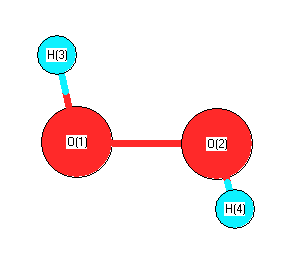Jump to
S1C2
Energy calculated at QCISD(T)=FULL/aug-cc-pVDZ
| | hartrees |
|---|
| Energy at 0K | -151.248115 |
| Energy at 298.15K | -151.250392 |
| HF Energy | -150.798614 |
| Nuclear repulsion energy | 36.280614 |
The energy at 298.15K was derived from the energy at 0K
and an integrated heat capacity that used the calculated vibrational frequencies.
Vibrational Frequencies calculated at QCISD(T)=FULL/aug-cc-pVDZ
| Mode Number |
Symmetry |
Frequency
(cm-1) |
Scaled Frequency
(cm-1) |
IR Intensities
(km mol-1) |
Raman Act
(Å4/u) |
Dep P |
Dep U |
|---|
| 1 |
A |
3752 |
3639 |
|
|
|
|
| 2 |
A |
1408 |
1366 |
|
|
|
|
| 3 |
A |
842 |
817 |
|
|
|
|
| 4 |
A |
387 |
375 |
|
|
|
|
| 5 |
B |
3752 |
3640 |
|
|
|
|
| 6 |
B |
1301 |
1262 |
|
|
|
|
Unscaled Zero Point Vibrational Energy (zpe) 5720.3 cm
-1
Scaled (by 0.9701) Zero Point Vibrational Energy (zpe) 5549.3 cm
-1
See section
III.C.1 List or set vibrational scaling factors
to change the scale factors used here.
See section
III.C.2
Calculate a vibrational scaling factor for a given set of molecules
to determine the least squares best scaling factor.
Geometric Data calculated at QCISD(T)=FULL/aug-cc-pVDZ
Point Group is C2
Cartesians (Å)
| Atom |
x (Å) |
y (Å) |
z (Å) |
|---|
| O1 |
0.000 |
0.740 |
-0.059 |
| O2 |
0.000 |
-0.740 |
-0.059 |
| H3 |
0.797 |
0.897 |
0.473 |
| H4 |
-0.797 |
-0.897 |
0.473 |
Atom - Atom Distances (Å)
| |
O1 |
O2 |
H3 |
H4 |
| O1 | | 1.4801 | 0.9714 | 1.8975 |
O2 | 1.4801 | | 1.8975 | 0.9714 | H3 | 0.9714 | 1.8975 | | 2.4011 | H4 | 1.8975 | 0.9714 | 2.4011 | |
 More geometry information
More geometry information
Calculated Bond Angles
| atom1 |
atom2 |
atom3 |
angle |
|
atom1 |
atom2 |
atom3 |
angle |
| O1 |
O2 |
H4 |
99.326 |
|
O2 |
O1 |
H3 |
99.326 |
Electronic energy levels
Charges, Dipole, Quadrupole and Polarizability
Jump to
S1C1
Energy calculated at QCISD(T)=FULL/aug-cc-pVDZ
| | hartrees |
|---|
| Energy at 0K | -151.246245 |
| Energy at 298.15K | |
| HF Energy | -150.796495 |
| Nuclear repulsion energy | 36.124971 |
The energy at 298.15K was derived from the energy at 0K
and an integrated heat capacity that used the calculated vibrational frequencies.
Vibrational Frequencies calculated at QCISD(T)=FULL/aug-cc-pVDZ
| Mode Number |
Symmetry |
Frequency
(cm-1) |
Scaled Frequency
(cm-1) |
IR Intensities
(km mol-1) |
Raman Act
(Å4/u) |
Dep P |
Dep U |
|---|
| 1 |
Ag |
3776 |
3663 |
|
|
|
|
| 2 |
Ag |
1513 |
1467 |
|
|
|
|
| 3 |
Ag |
837 |
812 |
|
|
|
|
| 4 |
Au |
309i |
300i |
|
|
|
|
| 5 |
Bu |
3785 |
3672 |
|
|
|
|
| 6 |
Bu |
1223 |
1186 |
|
|
|
|
Unscaled Zero Point Vibrational Energy (zpe) 5411.8 cm
-1
Scaled (by 0.9701) Zero Point Vibrational Energy (zpe) 5250.0 cm
-1
See section
III.C.1 List or set vibrational scaling factors
to change the scale factors used here.
See section
III.C.2
Calculate a vibrational scaling factor for a given set of molecules
to determine the least squares best scaling factor.
Geometric Data calculated at QCISD(T)=FULL/aug-cc-pVDZ
Point Group is C2h
Electronic energy levels
Charges, Dipole, Quadrupole and Polarizability
